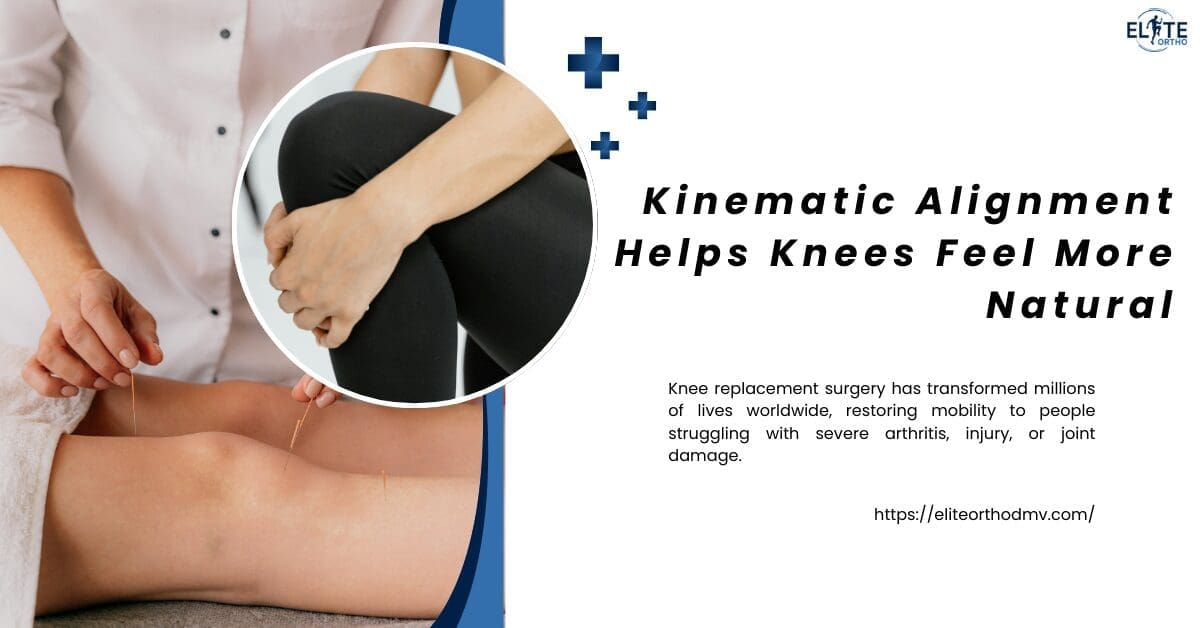Knee replacement surgery has transformed millions of lives worldwide, restoring mobility to people struggling with severe arthritis, injury, or joint damage. Despite the great success rate of standard total knee replacement (TKR), many patients complain that their new knees don’t feel completely “natural.” It can still be painful to have stiffness, restricted range of motion, or trouble with basic everyday tasks.
Kinematic knee replacement, an effective, personalized method, can help with it. In order to create knees that not only function but also feel like your own again, kinematic alignment focuses on each person’s own anatomy and movement patterns.
The Problem with the Traditional “One-Size-Fits-All” Method
Doctors commonly use a procedure known as mechanical alignment in traditional knee replacement surgery. Placing the knee implant in a consistent, “straight” position in relation to the body’s bones is the aim here. This technique is effective for alignment and durability on X-rays, but it doesn’t always take into consideration the natural changes in the shape and action of people’s knees.Each patient has a different knee. When you walk, run, or climb stairs, your natural alignment—which can be a little bow-legged or knock-kneed—helps decide how your joint moves. These variations can be “corrected” by mechanical alignment, although the patient may find this change to be unnatural.
According to research, 10–15% of patients remain unhappy because the new joint feels stiff and unstable, or just “not their own,” even though 85–90% of people are satisfied with their knee replacement.
What Is Kinematic Alignment?
The surgical concept known as kinematic alignment (KA) is an ideal shift. KA respects the patient’s natural, pre-arthritis anatomy rather than moving each knee into the same standard posture.Surgeons position the implant to restore the patient’s normal mobility route, ligament balance, and individual joint lines using advance imaging, computer planning, and exact tools. To put it simply, the new knee is made to fit you, not the other side around.
This approach aims to:
- Bring back your first movement and bend your knee before you get arthritis.
- Reduce the amount of time that surrounding ligaments wanted to be improved or released.
- Restore stability and comfort while performing daily tasks.
Benefits of Kinematic Knee Replacement
- Customized Joint Replacement
Each knee replacement is customized based on the anatomy of the patient. Surgeons use your joint’s specific angles and contours to plan it out rather than a generic design. This results in a more natural fit because the artificial joint is set up to match the motion of your own knee. - Natural Movement
By aligning the new joint to your body’s natural motion, patients often notice a smoother, more fluid movement. The knee feels less “artificial,” making workouts like squatting, sitting cross-legged, and climbing stairs simpler. - Improved Mobility and Function
It is common for patients who have kinematic knee replacement to regain mobility faster than those who have physically aligned implants. Research finds improvements across joint function, balance, and walking patterns. According to many patients, the knee “feels like it belongs to me.” - Long-Term Outcomes
Durability is a major consideration for any joint replacement. According to early research, kinematic alignment does not shorten the lifespan of surgical instruments; on the contrary, it may improve long-term results by restoring natural balance and lowering outside stresses on the implant. Less problems, fewer changes, and happier patients are the results of this.
Who Is a Candidate for Kinematic Alignment?
Many people with advanced arthritis can benefit from KA, but not everyone is a good fit.- A more natural feel post surgery is typically desired by patients, making them potential patients.
- individuals without major ligament issues or bone abnormalities.
- Individuals motivated to regain a high level of activity.
The Role of Technology
Benefits in surgical technique and planning help kinematic knee replacement. Surgeons can use CT scans and 3D imaging to understand the anatomy of each patient.- Robotics or computer navigation can increase implant placement accuracy.
- Patient-specific instruments (PSI) are made to precisely fit the joint’s form.
Expectations for the Patient Experience
Kinematic knee replacement patients will experience a repair period and hospital stay that is comparable to that of regular TKR. Nonetheless, many people say that early in the healing process, the knee feels more natural and sturdy. Typical recovery milestones include:- Within 24 to 48 hours follow surgery, walking with assistance.
- Return to regular activities gradually in 4-6 weeks.
- Improvements over three to six months in functional movement, stair climbing, and balance.
- Long-term satisfaction that the new knee feels more like the “real thing.”
The Future of Knee Replacement
Kinematic alignment is something of the bigger trend in orthopedics towards personalized medicine, which refers to the practice of treating patients according to their specific bodies rather than using a one-size-fits-all approach. For patients, this means knee replacements that actually enhance comfort, mobility, and quality of life in addition to looking beautiful on X-rays. We can expect much more rapidity and personalization in joint replacement surgery as technology improves.Conclusion
Kinematic knee replacement is an exciting breakthrough in orthopedic care because it respects your body’s natural shape and how your knee moves. Unlike traditional knee surgery, it offers a more personalized approach that feels more natural.
The benefits like a better fit, smoother movement, improved mobility, and strong long-term results make it a great choice for anyone looking for more than just a new knee, but a chance to truly enjoy life again.
If you’re thinking about knee replacement, have a conversation with your surgeon about whether kinematic alignment could be right for you. It might be what helps you not only replace your knee but also regain your real freedom of movement.


